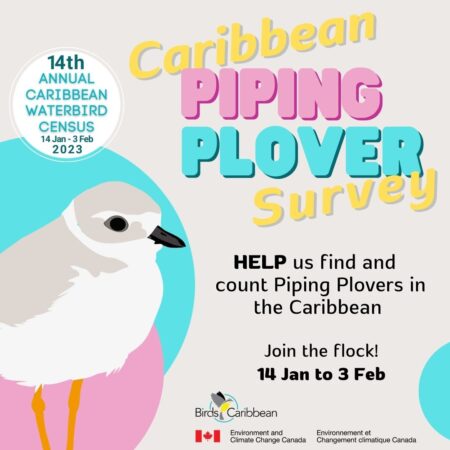
This small, round shorebird is listed as “Near Threatened” by the IUCN with an estimated global breeding population of just 8,400 birds. They breed in restricted areas of North America but migrate south in fall with some birds spending their winter in the Caribbean. It’s vital that we continue to learn more about the numbers and distribution of this rare shorebird in our region. Read on to find out how you can help us.
The 14th annual Caribbean Waterbird Census (CWC) Region-Wide count will be taking place at the start of 2023, from January 14 to February 3. This year we are asking you to make a special effort to find and count Piping Plovers. You can do this by planning your CWC surveys in places where Piping Plovers have been seen before (explore their sightings on eBird). Or by doing surveys in places where there might be suitable habitat for wintering Piping Plovers. We have plenty of information and resources to help you plan your surveys and pick out Piping Plovers from the pack!
Track Piping Plover Sightings Live!
We are tracking where Piping Plovers have been seen during CWC 2023. Send us your sightings as you make them and we will update the map. This mean you can track our progress in finding Piping Plover live during the survey. Click on each point for more information about each sighting.
Zoom in or out to view your region or the whole Caribbean. Click the icon in the top right corner to see a larger map. You can share your sightings, including a grid reference and your count of Piping Plovers at that location (if more than one was seen) with waterbird.manager@birdscaribbean.org or on the BirdsCaribbean listserv.
NOTE: If you are not within the Caribbean but have seen a Piping Plover during the CWC survey period you can still share your sightings and we will add them to the map! And we will continue to add all sightings of Piping Plovers in 2023 to this map, so please continue your CWC counts and send us your eBird Caribbean checklists. Remember that although we have one annual 3-week regional count period (14 Jan-3 Feb), we encourage everyone to carry out CWC counts year-round, especially during fall and spring migration. We need much more information on all the habitats that shorebirds and waterbirds use throughout the year. Thanks!!!
What to look for
Piping Plovers are small, round shorebirds with ‘stubby’ black bills and orange legs. Their upper parts are pale brown, the colour of dry sand, and they are white below. We have made a handy ID guide to help you pick out Piping Plovers from some of the other small plovers that winter in the Caribbean.
Download these graphics as a pdf following these links: Plover ID guide Guide to reading bands
They also have a unique two-note high to low pee-too call that you can listen out for.
Piping Plovers can be quite vocal, even during the winter. They often give a mellow two-part whistle, that drops in pitch, pee-too. Sometimes they only give the first part of this call as single, repeated with several seconds between each call: pee … pee … pee.
These little birds can sometimes be very tricky to spot and blend in to their surrounding so you’ll need to look carefully to find them! If you do find any Piping Plovers don’t forget to scan their legs for colour bands. Finding and reporting these bands can help us learn more about where different breeding populations spend the winter. You can find out how to report bands in our helpful guide (above). More information and different versions of this guide to reporting banded Piping Plovers are available to download on our Shorebird Resources webpage.
Where to look
Thanks to dedicated survey efforts over the past few years, we already know about some of the main islands and areas where Piping Plovers spend the winter in the Caribbean, including the Bahamas, Cuba, and Turks and Caicos Islands. We also know they have been spotted in smaller numbers in other countries, including Puerto Rico and its offshore islands and cays, the Dominican Republic, Jamaica, the US and British Virgin Islands, St Kitts, Guadeloupe, Anguilla, and Bonaire (there are just one or two records for some of these countries). But in the ‘right’ habitat there are likely more Piping Plovers to be found, both in ‘new’ locations on islands where they have been seen before and perhaps some islands where they haven’t been seen yet. We need more people out there looking for them!
Piping Plovers in the Caribbean are often seen in small flocks resting and feeding on sand flats. Even here, out in the open, they can be tricky to spot with their ‘dry sand’ coloured plumage blending with their surroundings. Be sure to also check any seaweed (wrack) on the beach as this is another favourite haunt of theirs. Other places Piping Plovers might be found include mudflats, mangroves, and along rocky areas of shoreline, where again they blend in beautifully, especially if they are resting. Check out and share our handy graphics, with artwork by Josmar Esteban Márquez, to remind you where to look.
Click on each image to enlarge then right click to “save as….” a jpeg. Use these links to download each image in higher resolution as a pdf: Sand Flats, Mangroves, Beach Wrack, Rocky Shore
You can also get a much more extensive guide to surveying Piping Plovers, their habitats, techniques for survey, and ID tips by watching our helpful “Piping Plovers in the Caribbean: Identification, Habitats, and Practical Considerations for Winter Surveys” webinar given by Piping Plover survey expert Sidney Maddock.
Be part of the Plover Patrol
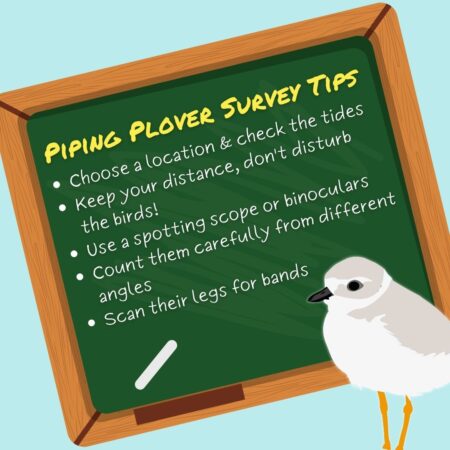
We want as many people as possible to join in our effort to look for Piping Plovers during the 2023 CWC regional count period. Be sure to watch Sidney Maddock’s webinar before you plan your surveys. You can also use and share these survey tips to get the most out of your Piping Plover surveys.
When you do your surveys please treat them like all your other CWC surveys. This means you should count all the bird species that you see (in addition to any Piping Plovers). Make sure you enter your data in eBird Caribbean using one of the CWC protocols on Step 2 of data entry (online). If using the eBird app, set your portal to eBird Caribbean to access the CWC options for your checklists.
Thanks to Environment and Climate change Canada for helping to funding these resources and our efforts to survey Piping Plovers during our 2023 CWC!

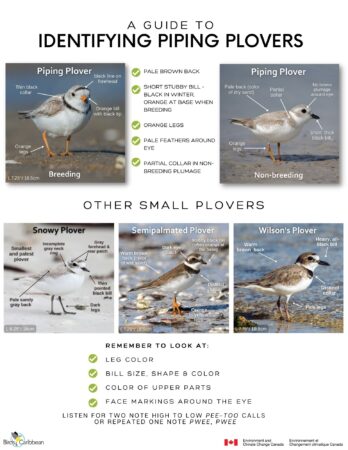
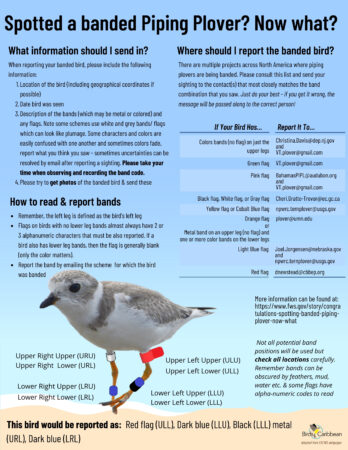
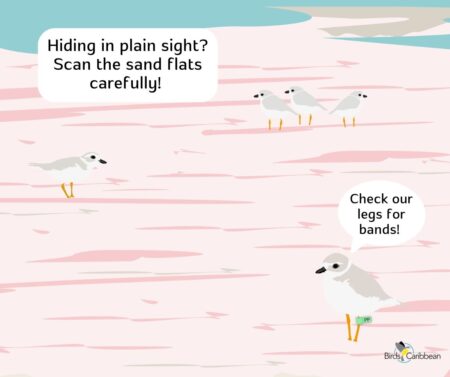
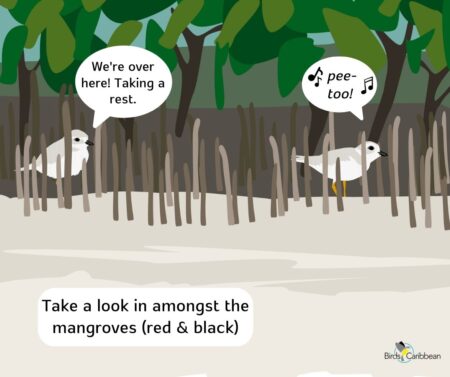
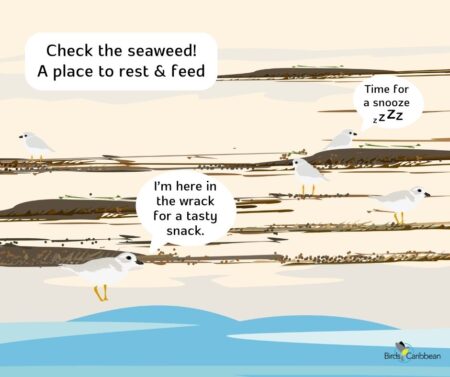
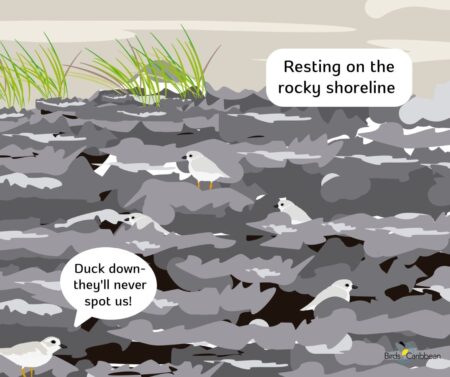
Hola soy Juan flores de Green Jay Bird Conservancy . Trabajamos en la Península de Yucatán , toda la costa este de la.Peninsula ,isla mujeres y la isla de Cozumel son parte del caribe Mexicano, estamos en el canal de Yucatán compartiendo con Cuba y otras Islas .
En la parte noreste del caribe Mexicano cerca de Cancún está isla Blanca una zona importante para el piping plover . También la isla de Holbox tiene observaciones . Queremos participar en el conteo y ver qué se nos incluya en los programas de Birds Caribeean estamos muy interesados en participar .
Hola Juan, me alegro de saber de ti y gracias por ponerte en contacto con nosotros para participar en nuestro Censo de Aves Acuáticas del Caribe. Tu participación, especialmente si vas a censar zonas con chorlitejos patinegros, será muy bien recibida. La misión de BirdsCaribbean se centra en el Caribe insular (incluidas las Bermudas, las Bahamas y todas las islas de la cuenca del Caribe), por lo que México quedaría fuera de este ámbito. Sin embargo, siempre nos complace que participen en nuestros programas personas vinculadas al Gran Caribe y, por supuesto, son bienvenidos a utilizar todos nuestros materiales gratuitos y recursos en línea y descargables para ayudarles. Estaríamos especialmente interesados en conocer sus avistamientos de chorlitejos comunes durante este invierno. Por favor, asegúrate de usar eBird para registrar los datos de tus censos. Si lo deseas, puedes utilizar uno de los protocolos del CWC para hacerlo (a través de eBird Caribbean). Háganos saber si tiene alguna pregunta sobre el CWC- Puedes contactarme en waterbird.manager@birdscaribbean.org.
Gracias Alex
Traducción realizada con la versión gratuita del traductor http://www.DeepL.com/Translator